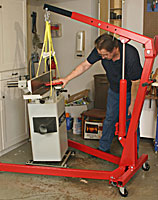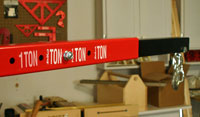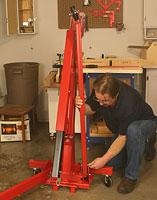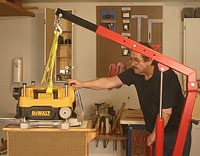This is a Veteran Owned site
![]()
 |
Moving or assembling machines can be dangerous to you and the machine. The shop crane makes these tasks easy and safe. Click image to enlarge |
1-Ton Folding Shop crane
Getting old/sensible the smart way
Text & photos by tom Hintz
Posted – 2-21-2007
Woodworkers love cast iron, especially when it comprises large portions of heavy machines. The problem for many of us is that by the time we get to a place in life where we can afford cast iron in satisfyingly large hunks, lifting or even moving that kind of weight around is at best ill advised. For those who refuse to accept their less than superhuman capabilities, the result can be damage to a machine – or them.
After struggling for too long with machines in my shop, a mix of common sense and the instinct for self-preservation ratcheted my ego down sufficiently for me to realize that there had to be a better (and safer) way. What was especially frustrating is that the solution is nearly identical to a piece of equipment I used frequently through most of my life.
Hydraulics, An Old Friend
 |
The extendable boom gives plenty of reach and capacity in my shop. Click image to enlarge |
In my previous life in racing, hydraulic engine hoists were a frequently used piece of equipment. Recently, I noticed fold-up versions with lift capacities more in line with shop use. That bit of downsizing also brought the price down enough to fit my budget.
Within a week, I had a shinny new hydraulic shop crane and a few lift straps in the shop. In addition to the euphoria of having a new tool in the shop, my increasingly fragile back was anticipating better times.
A word of caution: Getting the shop crane home can be a dangerous final bit of bravado if you choose to do it yourself. As you might expect, this is not a light nor easily handled carton. Taking advantage of to-the-door shipping can be a wise choice. From there, cut the carton open and take it out in pieces for assembly.
Storage
 |
 |
(left) Folding the shop crane for storage is a 3-minute task involving relocating two pins and flipping out the front leg bracket. (right) In the stowed configuration my new shop crane uses almost no useable floor space. Click image to enlarge |
|
Before you vapor lock over potential storage problems let me say that the fold-up moniker actually fits this style of shop crane. In it’s stowed configuration my shop crane is 30 1/2"”-wide, 19 1/4"-deep and 61 ”-tall. It is also on wheels which makes moving it to an available storage spot a low-stress driving chore.
In The Shop
Assembling my new 1-ton capacity shop crane went smoothly. After a half-hour or so, I was ready to lift things with the greatest of ease. Before hooking anything up, I ran the hoist through its range of travel and found that it would easily go to the ceiling in my garage-based shop and still reach down close to the floor. That range of motion means lifting most things will be no problem, including setting them on benches or bases. I also set the multi-position boom extension to its mid-point. That appeared to offer the best reach while still maintaining 1000 lbs of lift capacity.
 |
At just over 90 lbs, this planer is a hand full. Lifting it onto a cabinet that is high enough to not antagonize my back is out of the question without the shop crane. Click image to enlarge |
I had also purchased a pair of 6’-long lifting straps to get started though I fully expect to add other lengths in the future to accommodate new machines and tasks. Good lift straps cost between $12 and $25 depending on length and capacity which is nearly always far more than woodworkers need. In addition to their strength, lift straps do not mar the surface of our shinny new machines and fold up for easy storage.
In addition to letting the shop crane do the lifting, the hydraulic cylinder makes it easy to gently set something down. That includes lowering a piece of equipment just above a stand or mount to make aligning it nearly effortless and far more safe than trying to man-handle it with anything approaching control or precision.
Another task that the shop crane makes easy is lifting assembled machines onto a mobile base. In the past, I often built new machines right in the base because there was no safe way of getting it in there afterwards. The shop crane makes this bit of heavy lifting easy and safe.
Before actually using the shop crane I was a little concerned about getting it’s extended legs around the various bases and cabinets on which equipment had to be placed. That turned out to be a moot point as the legs easily fit around everything I had in the shop. I realize this may not always be the case but between the spread of the shop crane legs and its reach, getting a tool into position should not be a big problem. Certainly not even close to the dangers of trying to do it by hand, even with the help of a second person who in my world is never around when I need them.
Conclusions
I know a shop crane is not for everyone. However, it can be a very useful piece of equipment for those of us who realize our heavy-lifting limitations. In addition to machinery, a shop crane can make moving larger projects around safer for you and them.
With a street price around $199 (2-20-2007) for models with a 1 to 2 ton capacity a folding shop crane can be a cheap way to prevent costly injuries, sore backs and damaged machines. For those of us entering our reputedly golden years, a shop crane just makes sense.
Have a comment on this review? –Email Me!
All written, photographic and drawn materials are property of and copyright by NewWoodworker.com LLC 2000-2019. Materials may not be used in any way without the written permission of the owner.
